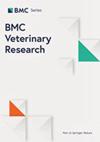Molecular and in silico analyses for detection of Shiga toxin-producing Escherichia coli (STEC) and highly pathogenic enterohemorrhagic Escherichia coli (EHEC) using genetic markers located on plasmid, O Island 57 and O Island 71
IF 2.3
2区 农林科学
Q1 VETERINARY SCIENCES
引用次数: 0
Abstract
Due to the diversity of Shiga toxin-producing Escherichia coli (STEC) isolates, detecting highly pathogenic strains in foodstuffs is challenging. Currently, reference protocols for STEC rely on the molecular detection of eae and the stx1 and/or stx2 genes, followed by the detection of serogroup-specific wzx or wzy genes related to the top 7 serogroups. However, these screening methods do not distinguish between samples in which a STEC possessing both determinants are present and those containing two or more organisms, each containing one of these genes. This study aimed to evaluate ecf1, Z2098, Z2099, and nleA genes as single markers and their combinations (ecf1/Z2098, ecf1/Z2099, ecf1/nleA, Z2098/Z2099, Z2098/nleA, and Z2099/nleA) as genetic markers to detect potentially pathogenic STEC by the polymerase chain reaction (PCR) in 96 animal samples, as well as in 52 whole genome sequences of human samples via in silico PCR analyses. In animal isolates, Z2098 and Z2098/Z2099 showed a strong association with the detected top 7 isolates, with 100% and 69.2% of them testing positive, respectively. In human isolates, Z2099 was detected in 95% of the top 7 HUS isolates, while Z2098/Z2099 and ecf1/Z2099 were detected in 87.5% of the top 7 HUS isolates. Overall, using a single gene marker, Z2098, Z2099, and ecf1 are sensitive targets for screening the top 7 STEC isolates, and the combination of Z2098/Z2099 offers a more targeted initial screening method to detect the top 7 STEC isolates. Detecting non-top 7 STEC in both animal and human samples proved challenging due to inconsistent characteristics associated with the genetic markers studied.利用位于质粒、O 岛 57 和 O 岛 71 上的遗传标记检测产志贺毒素大肠杆菌 (STEC) 和高致病性肠出血性大肠杆菌 (EHEC) 的分子和硅学分析
由于产志贺毒素大肠杆菌(STEC)分离物的多样性,检测食品中的高致病性菌株具有挑战性。目前,STEC 的参考方案依赖于 eae 和 stx1 和/或 stx2 基因的分子检测,然后再检测与前 7 个血清群相关的血清群特异性 wzx 或 wzy 基因。然而,这些筛查方法并不能区分样本中同时存在两种决定性基因的 STEC 与含有两种或两种以上生物体(每种生物体含有其中一种基因)的样本。本研究旨在评估作为单一标记的 ecf1、Z2098、Z2099 和 nleA 基因及其组合(ecf1/Z2098、ecf1/Z2099、ecf1/nleA、Z2098/Z2099、Z2098/nleA 和 Z2099/nleA)的遗传标记,以便通过聚合酶链反应(PCR)检测 96 份动物样本中可能致病的 STEC,以及通过硅 PCR 分析检测 52 份人类样本的全基因组序列。在动物分离物中,Z2098 和 Z2098/Z2099 与检测到的前 7 个分离物有很强的关联性,分别有 100% 和 69.2% 的分离物检测呈阳性。在人类分离物中,前 7 位 HUS 分离物中 95% 检测到 Z2099,而前 7 位 HUS 分离物中 87.5% 检测到 Z2098/Z2099 和 ecf1/Z2099。总之,使用单一基因标记物,Z2098、Z2099 和 ecf1 是筛查前 7 位 STEC 分离物的敏感目标,而 Z2098/Z2099 的组合提供了一种更有针对性的初步筛查方法,可检测前 7 位 STEC 分离物。由于与所研究的遗传标记相关的特征不一致,在动物和人类样本中检测非前 7 位 STEC 具有挑战性。
本文章由计算机程序翻译,如有差异,请以英文原文为准。
求助全文
约1分钟内获得全文
求助全文
来源期刊

BMC Veterinary Research
VETERINARY SCIENCES-
CiteScore
4.80
自引率
3.80%
发文量
420
审稿时长
3-6 weeks
期刊介绍:
BMC Veterinary Research is an open access, peer-reviewed journal that considers articles on all aspects of veterinary science and medicine, including the epidemiology, diagnosis, prevention and treatment of medical conditions of domestic, companion, farm and wild animals, as well as the biomedical processes that underlie their health.
 求助内容:
求助内容: 应助结果提醒方式:
应助结果提醒方式:


